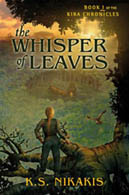 | K.S. Nikakis THE WHISPER OF LEAVES Arena Allen & Unwin, 403 pp. Source: review copy Review by Perry Middlemiss |
High fantasy is a very popular genre within the speculative fiction world. It can be said to have emerged in its modern form in the writings of J.R.R. Tolkein, and some might even suggest it reached its high-point there. The genre is characterised by its setting - usually a world very similar to our own - its historical time-frame - very definitely a pre-industrial age - and by its serious tone. Often, such novels feature magical or mythical creatures such as wizards, elves, dragons and the like, so this novel's lack of such supernatural or fantastical beings presents as a breath of fresh air.
Many years before the opening of The Whisper of Leaves, twin gold-eyed princes had a falling out and split their kingdom apart. One stayed true to his warrior past, while the other left home to found a community deep within a vast southern forest. In the novel's prologue, a descendant of the warrior prince, the leader of the Shargh tribe, receives a prophecy that seems to foretell the extinction of his people. The prophecy implies that the threat will emerge from amongst the Tremen, the forest people who have turned away from industry and founded a society whose highest achievement is that of Healing. The novel follows the story of Kira, a seventeen-year-old girl with a highly developed Healing ability, who the Shargh believe is the golden-eyed destroyer of their prophecy. Initially sheltered by the forest and the extended community on which she lives, Kira is portrayed as a rebellious spirit who toes the expected line only as a last resort. An incursion into the forest by the Shargh leads to her discovery and a series of armed raids in which a number of Tremen are killed. Kira's response to that armed struggle decides her fate up to the end of this novel, and into subsequent books, though how many that will be is rather uncertain.
A major component of many, if not all, high fantasies is the battle between good and evil, order and chaos. This major dichotomy is generally clearly delineated: there is black and there is white, with little grey muddying the mix. This distinct division between opposing forces allows an author to ratchet up the tension whenever the two forces interact, and to use them as a means of examining the mental and physical fortitude of the hero. Nikakis doesn't shy from this tradition - in fact she embraces it whole-heartedly - but she does shift the usual split from sword/magic to sword/healing, or, if you like, industrial/hunter-gatherer. As is again common in this genre, the good/evil split is usually based on race, culture, country or tribe lines. Here it revolves around both culture and tribe, as the two components are inseparable: all Tremen Healers are hunter-gatherer vegetarians, and all members of the Shargh are hunters or farmers of animals. This is not to say, however, that all members of the Tremen are warm and wonderful, and all Shargh are sword-wielding carnivores; Nikakis is not that simplistic. The major conflicts exist between the two tribes but there are other, more subtle, divisions within each which tend to enrich the tale being told. These internal conflicts aren't fully resolved within this volume. Some are, and some have a direct influence on the story outcomes here, but a number are obviously there for the long haul. You get the distinct feeling that the author has a fair idea of where the story is heading, and why. In a multi-volume series such as this, that understanding gives the reader a certain level of confidence that his or her investment in the extended work won't be time wasted.
There are some problems with the novel, which, depending on your understanding of the genre, will prove easy to handle or become a major obstacle to getting through the first 80 or pages. In order to set the stage for the rest of the novel and, in this case, for the rest of the series, a large amount of information - about the world depicted, its peoples and its history - has to be provided to the reader in rather large chunks. The worst form of this is the boring exposition technique, normally referred to as "telling rather than showing": "Now, John, as you well know, two hundred years ago our ancestors...blah,blah,blah..." and so on and so forth for a couple of pages of dense stupefying prose. Nikakis doesn't fall into this trap but still struggles a little to get the required information to the reader in a lively fashion. Once she gets past this scene-setting the novel shows a better sense of pace and it's possible to settle back and enjoy the ride.
I wouldn't go so far as to say that K.S. Nikakis has made an auspicious debut with this novel - it doesn't "blow you away" and tends to be a bit slow in places - but its world-building, its interesting take on some classic fantasy tropes, and its storylines set up enough hooks to ensure that this reader will be looking for the following volumes in the series.
